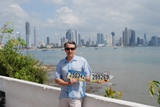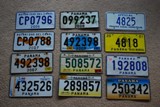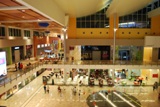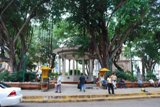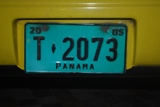Panama Odds and Ends
This is part three of my Panama trilogy. I blogged about the casino scene in Panama City in two previous articles: The Gambling Scene in Panama and Confessions of a Canfrejo. This entry focuses on the tourist activities I managed to squeeze in between my casino research and business meetings.
If you see just one thing in Panama City, it should be the Panama Canal. The canal is 48 miles long with a lake in the middle. I would suggest going to the Miraflores Locks, which is closest to Panama City, just outside the city. It is a two-step lock that elevates the ships eight meters. There is another set of locks further inland, taking ships up to the lake level, and another set on the Caribbean side which lowers ships from the lake level to the sea.
A taxi ride from the center of Panama City to Miraflores will cost about $15 in a yellow cab and $20 in a white one. I'll tell you more about the taxis later. The Miraflores visitor center is a four-story building with a nice viewing area on the top floor. The inside has a museum, theater, restaurant and overpriced gift shop. As I recall, a ticket for everything was about $8. I call the gift shop overpriced because I paid $25 for a license plate there that I would later find elsewhere for $10-$15.
During the hours of operation, the ships go toward the Caribbean from 9 a.m. to 11 a.m. Then nobody goes through for four hours. From 3 p.m. to 5 p.m., ships go the other way, towards the Pacific. So make sure you get there for one of the two crossing periods. I got there right at 11 a.m. and had to sit around for four hours to see a ship. During this time, I enjoyed a time-elapsed video in the museum of a crossing of the entire canal and a movie about the history of the canal.
As I waited, I feasted on churos and beer in the snack bar. The churos were the best I have ever had. Between the two main Panamanian beers, Panama and Balboa, I thought Balboa was much better. It had a sharp and slightly bitter taste, while Panama was very light and watery. If comparing them to Mexican beers, I would say Balboa is like Tecate and Panama is like Corona.
When the ships started to make their way through, I took the following pictures at five minute intervals. It was suddenly very crowded on the observation deck and a little difficult to find a spot at the railing. It was also agonizing, as the American next to me was trying to impress his girlfriend with his knowledge of the canal ? all of his assertions completely wrong. I tried to correct him at one point, but he blew me off. This I should have expected. I see the same thing happen in Vegas all the time, but about gambling.
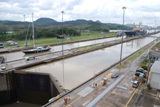 |
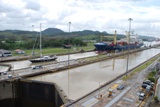 |
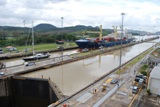 |
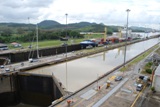 |
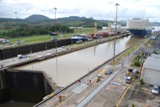 |
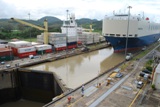 |
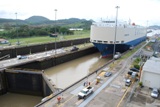 |
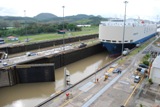 |
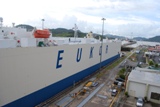 |
Here are a few more miscellaneous pictures from the canal.
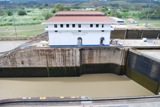 |
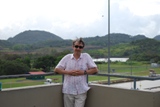 |
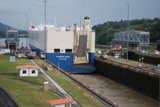 |
The next day, I took a historical tour of Panama City. The first place we went was in the former Canal Zone. This part of Panama was controlled by the United States until 1999, and is still a very nice area and retains an American look to it. Then we went to a restored village called "Mi Pueblito." This was meant to show what life looks like in small villages in Panama. A little touristy, but it's worth doing if you're in the canal zone area and have extra time. It is along Avenida de los Martires, up a hill in a forested area. I'd give you a street address, but they don't have them in Panama, nor mail service.
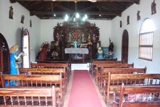 |
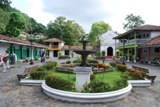 |
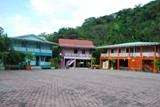 |
The next stop was a church called the Alter de Oro (Alter of Gold). All I can remember is a lot of gold from Peru came through Panama on its way to Spain. Some of it was used to make this church altar, which is hundreds of years old. I tend to doubt there was actually much gold there, as I didn't see much in the way security.
Then we went to the French part of the city, known as San Felipe. Little did I know before this trip that France was the first country to attempt to build the canal, but they gave up after too many people died of malaria. However, their influence remains in the San Felipe section of the city. The buildings look much like those in the French Quarter of New Orleans. I was planning to take pictures on my way back to the van, but we got picked up in another spot. All I have is this picture from there looking towards the downtown area. I also easily got my fix of Panamanian license plates. I'm an avid collector, and some of the vendors had a good selection. My advice for souvenir hunters is to head to this part of town.
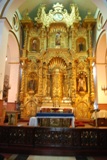 |
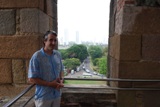 |
||
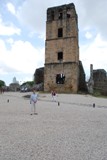 |
|||
The next stop on the tour was the Casco Viejo (old town) section of the city. This was where the city first stood, before pillaging and fires caused it to move further west. The main point of interest, and the only thing we had time to see, was the Iglesia Cathedral. Our guide emphasized that this was the oldest standing structure along the Pacific Ocean in all of the Americas. It has been heavily damaged, and then restored, so not much of the original structure remains. They added a staircase to get a look from the top.
The following pictures were taken from each direction.
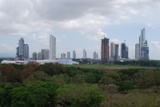 |
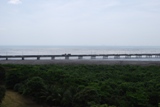 |
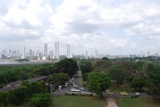 |
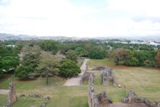 |
I'm afraid for a week in Panama that is about all the sightseeing I did. I spent most of my time in casinos, which I wrote about in part II of my Panama trilogy. However, here are some miscellaneous pictures I took elsewhere in the city.
Below is a picture of the Multiplaza Pacific shopping center. I must say I was not expecting to see such high-end shopping in Panama. It is close to the Punta Pacifica section of the city, which is made up of modern skyscrapers, most of them banks. Quite a contrast to the other parts of the city.
This is in the Cinco de Mayo Plaza area of the city. It has a street blocked off to car traffic, making it a nice place to wander around. I asked my tour guide if the plaza's name referred to the battle between Mexico and France that is celebrated in the U.S. He said the Panamanian Cinco de Mayo has nothing to do with the Mexican one, but I think he was in error.
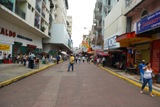 |
So my knowledge of Panamanian history didn't get any better, but I did get a good salon haircut in the area for $6. I wasn't sure if I was expected to tip, so I didn't. When I relayed the story to a local later, she said I should have. Now I feel bad.
Another evening, I went to the Calle 49 section of the city, also known as Calle Replublica de Uruguay. The Lonely Planet guide said this was the trendy disco/restaurant area of the city, and I think they are right. There were lots of restaurants and bars. My guide took me to a great place for dinner ? the best meal I had in Panama by far. However, after much searching, I can't determine the name of it. I know, I'm terrible. After dinner, we went to a jazz club and then a dance/karaoke place called Star Light, which was a lot of fun, and not nearly as expensive as Vegas clubs.
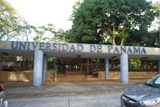 |
Another day I wandered around the University of Panama and then this modern Catholic Church. Many of the university buildings look in disrepair, but it was a quiet place to escape the noise of the rest of the city.
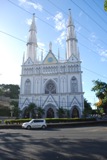 |
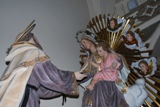 |
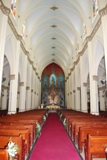 |
Here are some other pictures I took near my hotel. The buses all look like these, which is very cool.
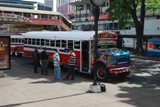 |
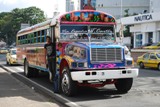 |
Here are some pictures of my own hotel, the Riande Contenintel.
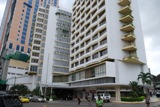 |
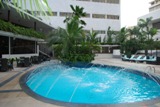 |
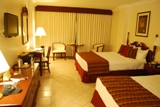 |
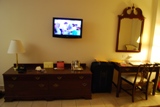 |
Finally, here are some miscellaneous pieces of advice.
LANGUAGE
Spanish is the official language. Not many people speak English. Of course, your odds of encountering English are better in the touristy areas, but don't count on it.
FOOD
After spending a week in Panama, I still don't know if there is a specific thing called Panamanian Food. There were lots of ethnic restaurants, as in the U.S. However, your basic simple restaurant served things not much unlike what I see at home, in particular a lot of fish, chicken and rice. Just from the one delicious meal I had there, and eyeballing other restaurants, it seems the best odds of finding something good is in the Calle Republica de Uruguay area. There is also a good restaurant across the street from the Marriott called Beirut, which, obviously, serves Lebanese food.
TRAFFIC
Traffic is horrible in Panama City. During rush hours, traffic moves extremely slowly. I would try to avoid traveling by car during those times. My advice is to try to concentrate on a particular part of town each day and minimize time on the road. Lots of streets lack sidewalks, which is also frustrating.
MONEY
Panama uses the U.S. Dollar, so no getting screwed with bad exchange rates or doing math in your head to convert prices.
TIPPING
I'm not still sure what to make of the tipping etiquette in Panama. However, here is my two cents on that topic:
Taxis: Tipping is not expected. However, if I felt I got a fair price, and the driver was nice to me, I would add a buck or two if I was in a good mood.
Restaurants: A 10% service charge is added almost always. Tipping is not expected beyond that. Personally, I just rounded up the next dollar.
Bellmen: There were always a host of bellmen hanging around the entrance of my hotel and they were always super nice to me. The first few days I didn't tip and I started to get the shakedown pretty hard. So I gave the person I saw the most $5 and that made things right again.
Casino dealers and cocktail waitresses: Tipping is not expected and seldom done.
Housecleaning: I have no idea. I left her a pile of change when I left.
Hair salons: As I wrote above, I got a very good haircut for $6, didn't tip, and now feel guilty about it. In a perfect world, tipping should be only for service above and beyond the call of duty, which it was in this case. It just goes to show you shouldn't always go by protocol but sometimes instead follow your heart.
TAXIS
There are two types of taxis in Panama City: yellow ones and white ones. The white ones are about 25%-50% more expensive but are nice, new vehicles, and I think you're less likely to get cheated by the driver. An annoyance with the yellow taxis is they sometimes pick up more than one set of passengers. Once when I flagged one down, there was already somebody else inside. The driver said he had to drop her off first, and she was going way out of my way. So what should have been a 10-minute drive turned into 30 minutes. In retrospect, I should have refused to get in.
If you ask for a taxi at a nice hotel, they will probably summon a white one. If you get one off the street, it will probably be yellow. I've read some comments on bulletin board warning about the white ones as being rip offs, but I think they're fine. You pay more, but you get more.
Neither color have meters, or if they do have one, they don't use it. If you don't ask for a price in advance, the driver will just throw a number from out of nowhere at you when you arrive, and it could easily be inflated. You should always ask in advance for a price. Even if you have no basis of knowledge of a fair price, just asking will help to keep the driver honest. Also, always have lots of small bills in your wallet. Twice when I was charged about $8 for a ride, I tried to pay with a $10, but the driver claimed he had to change. I didn't believe it, but what could I do about it? The next time I go to Panama I will have plenty of one-dollar bills on me.
At one point, I took a very short ride late at night and was charged $10 for what should have been a $2-$3 ride. Unfortunately, I didn't take my own advice about getting a price in advance. I told the driver I would pay the full amount if I could take a picture of his driver's license, or he could accept just $5, which was still too much. He made up lies and excuses about why he asked $10 but eventually drove off with $5. This is a picture of his license plate.
Finally, a ride from the airport to the center of the city should cost about $25. There will be a line of cabs at the airport. After I cleared customs I was approached by somebody who I thought was a driver, and I indicated I needed a taxi. He just led me about 30 feet to where to board the next taxi waiting, and then shook me down for a tip. Next time I will walk to the curb without help.
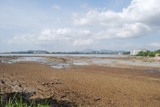 |
BEACHES
I had hoped to see white sandy beaches in Panama City, like in Honolulu, but alas, this is what I saw.
There are lots of islands along the coast, which I hear are very scenic with nice beaches. Unfortunately, I never had a chance to get outside the city.
SHOPPING
In general, I found prices in stores to be higher in Panama than in the United States. If you want to spend money, do it on services, which are much cheaper.
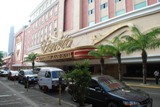 |
NAUGHTY SIDE
Gambling is legal in Panama. There are about nine hotels with associated casinos and about nine more that have slots only. I'm not sure if prostitution is legal in Panama, but it may as well be. There were lots of Columbian beauties strutting around the Veneto casino looking for customers. I was told the rate for the prettiest girls is $150/hr. I hear some of the strip clubs (they call them night clubs in Panama) have rooms you can take the girls to. Part I of my Panama trilogy deals a little more with that topic.
SUMMARY
I think Panama City is worth spending a day or two in if you are passing through. I'm happy I went but would probably not go there twice unless I had some compelling reason to.





